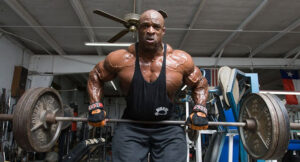There’s one thing that all lifters, whether recreational or professional, can agree on — when it comes to the back, bigger is better. A pair of well-developed lats and traps not only help you achieve that coveted V-taper look but also are some of the most powerful muscles in the upper body. Both are among the best back exercises you can do, but you might need a blueprint to decipher which one is right for you.
In previous articles, we’ve discussed the benefits of the barbell row and other back exercises commonly seen in power, strength, and competitive fitness training programs. While all rowing movements work your back muscles, some allow you to load with more weight to build optimal strength, while others are better for isolating one side of your body to fix muscle imbalances, increase your stability, and strengthen your core.
We’re going to go beyond the obvious and get into the nitty-gritty of the barbell and dumbbell row exercises and help you learn when to implement each.
Differences Between Barbell and Dumbbell Rows
At a glance, the two movements may look like close relatives, and they certainly are. However, there are enough unique features to each to warrant a discussion about not only the nature of each but where one excels over the other in terms of placement in a training plan.
Strength
Both the barbell and dumbbell row can build strength, although the barbell row often allows for higher amounts of loading to be rowed at once, making it better for overall strength development.
Hypertrophy
While you can certainly go heavy on a set of dumbbell rows if you have access to the right equipment, the comparatively lighter loading makes the dumbbell variant better suited to hypertrophy training, where a good mind-muscle connection is highly important to growth.
Muscular Imbalances and Asymmetries
Unilateral training has the ability to address muscular imbalances and correct asymmetries that may exist between the left and right sides of the body, so the dumbbell row is better for this. Barbell training often falls short in this category as the body may compensate to overcome any strength or movement imbalances.
Similarities Between Barbell and Dumbbell Rows
It goes without saying that the dumbbell and barbell rows are probably more alike than they are different. Identifying the areas they overlap can actually be helpful for understanding the differences by providing more context.
Multi-Joint
Although the barbell row and dumbbell row have their differences, they’re very similar movements and target the same muscles. They both target the main back muscle, the latissimus dorsi, and the smaller back muscles, such as the rhomboids and trapezius. Also, both exercises stimulate the biceps to some degree.
Hip Hinge
Both movements are rowing/pulling motions and require hip flexion with a straight back. To ensure you’re not placing any strain on your neck, look down at the floor instead of up.
Back Programming
The similar nature of the two movements generally means they’re applicable in almost any program that needs a reliable pulling movement. Both rows can be stapled exercises in a routine focused on building a strong, ripped back.
Barbell Row Vs. Dumbbell Row Technique
One of the major differences between the barbell row and the dumbbell row is that the barbell row is a bilateral movement — requiring both arms to pull the weight — whereas the dumbbell row is a unilateral movement, isolating only one side of your body. This difference affects both your setup of the exercise and the performance of the movement itself.
Bilateral Movement
Bilateral movements and unilateral movements differ significantly. Since the barbell row is a bilateral movement, you’ll be engaging your entire back musculature and both biceps to row the weight up. You’ll also be able to use heavier weights with the barbell, potentially leading to more stimulation. (1)
Bilateral movements also give you more stability, which means you’ll have more control over the weight you’re lifting and won’t have to focus on technique as much.
Unilateral Movement
Although bilateral movements allow you to lift heavier weights, the dumbbell row is a unilateral movement, which means you’ll be able to isolate each side of your back muscles separately.
This means you can correct muscular imbalances and work on lagging muscles on your weaker side, which will prevent you from relying too heavily on your dominant side to do all the heavy lifting for you. Fixing muscular imbalances can prevent injury and make your back muscles stronger overall.
Unilateral movements aren’t as stable as bilateral movements, which means you’ll also increase the strength of stabilizing muscles like your abdominals. (2)
Set Up and Positioning
A major difference between barbell rows and dumbbell rows is the position of your body. For example, the barbell bent-over row requires you to engage your hips and legs to provide a base of support, whereas the dumbbell row is done either on the bench or in a staggered stance.
This changes the dynamic of the movement because it involves the recruitment of different muscles. For example, with the barbell row, your hip and leg muscles help stabilize you to allow you to pull heavier weight than if you were using dumbbells while leaning on a bench.
How to Do the Barbell Row
Start off by getting into a shoulder-width stance and grab a barbell with a shoulder-width pronated grip (palms facing down) or supinated grip (palms facing up). Flex your hips and bend over, making sure to keep your back straight and relax your head and neck by looking down at the floor. Extend your arms to let the barbell hang, then row the barbell up and back while keeping the arms tucked to your sides.
Barbell Row Variations
The barbell row is a compound strength and hypertrophy exercise for the back, often used in strength, power, and general fitness programs. Below, you will find two common barbell row variations along with demonstrations to help facilitate muscle growth.
Underhand Row
While the barbell row is traditionally performed with an overhand, or pronated, grip, you can flip the hands to change up the stimulus.
Assuming a supinated grip will elicit more engagement from the biceps and possibly reduce strain on the elbows.
Pendlay Row
The Pendlay row differs from the bent-over row in that the load starts resting on the floor and is returned to the floor before beginning each successive repetition.
This can be used to increase concentric strength and stability in pulling movements such as the deadlift and clean, in addition to established benefits of barbell rows.
How to Do the Dumbbell Row
Place the knee opposite the arm you’re rowing with onto a bench, box, or other stable surface. Use the corresponding arm to support your torso by placing it on the bench as well. Make sure your back is straight and allow the free leg to extend behind you or to the side.
With the dumbbell resting on the floor beside the bench, pick it up with a neutral grip (palms facing the midline) and row it up and back towards your hip. Pull the weight in a controlled manner without listing your body to either side. Repeat on the opposite side.
Coach’s Tip: Be sure to initiate the pull by retracting the shoulder and not bending the elbow.
Benefits of the Dumbbell Single-Arm Row
- It engages your core more than a bilateral row.
- Isolating one side of the body allows for more targeted stimulation of a particular muscle.
Dumbbell Row Variations
The dumbbell row is a type of row that has the lifter perform rows with dumbbells, which can be beneficial for increasing the range of motion of the movement, address asymmetrical strength, and highlight any movement asymmetries one may have when performing bilateral upper body movements.
Dumbbell Upright Row
What separates the upright row from a standard dumbbell row is that it will target your upper back and engage your shoulders.
It’s worth noting that if you have a shoulder injury or impairment, this exercise may not be suitable for you.
Renegade Row
The renegade row is a combination between a row and a plank, one that stresses bodily control, core strength, and overall fitness.
While this row variation may limit the amount of weight you can row, it can help address any weaknesses with core strength and/or movement asymmetries.
The Barbell Row Vs. Dumbbell Row — When to Use Each
Knowing the differences between a barbell and dumbbell row — beyond the obvious — is all well and good, but the important part is knowing when one is better than the other for your needs.
For Strength
If your goal is to lift as much weight as possible to be the strongest you can, we recommend that you go with the barbell row. The barbell row will allow you to load the most weight and engage both sides of your body, which will get you stronger than the dumbbell row overall.
For Muscle Growth
The barbell row and dumbbell row are both great for muscular hypertrophy since you’ll be able to do a lot of volume with each, so it’s best to do both for a big back. Just make sure you’re doing enough volume with each movement.
For Sports Performance
When it comes to sports like weightlifting and powerlifting, the barbell is a piece of equipment a lifter should be highly familiar with. Movements like barbell rows (bent-over and Pendlay) have a good carryover to deadlifts and cleans. That said, failure to address any imbalances and pulling mechanics could also hinder performance. Therefore, both barbell and dumbbell rows can offer benefits to strength and power athletes.
If you play a sport that requires good core strength and stability — and most do — the dumbbell row might be your best option due to the unilateral element.
For Rehab
If you need to correct a muscular imbalance, accommodate an injured shoulder or elbow, or make any training-related adjustments, the dumbbell row is probably a better choice. The ability to isolate one side of the body while still performing a strong compound lift can ensure you hold onto your hard-earned muscle while also addressing physiological issues as needed.
The Bottom Line
Despite some of the differences between the barbell and dumbbell rows, both are beneficial when incorporated into a quality strength or hypertrophy program. The barbell row has an edge over its dumbbell cousin when it comes to maximal strength, but the dumbbell may be more effective for correcting muscular imbalances and improving your stability. Determine what your goals are, then implement the movement that meets your needs.
References
- Fenwick, C. M., Brown, S. H., & McGill, S. M. (2009). Comparison of different rowing exercises: trunk muscle activation and lumbar spine motion, load, and stiffness. Journal of strength and conditioning research, 23(2), 350–358.
- Saeterbakken, A., Andersen, V., Brudeseth, A., Lund, H., & Fimland, M. S. (2015). The Effect of Performing Bi- and Unilateral Row Exercises on Core Muscle Activation. International journal of sports medicine, 36(11), 900–905.

For more news and updates, follow IFBNewsfeed.Org on Facebook, Twitter, and Instagram.






